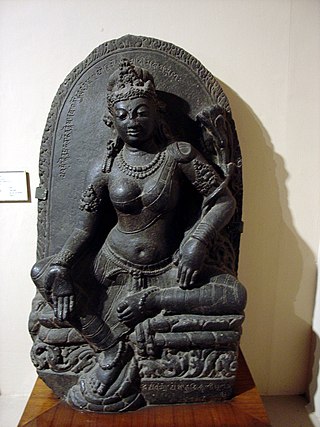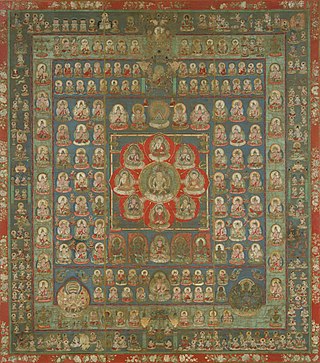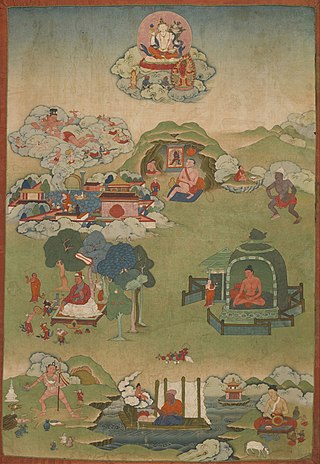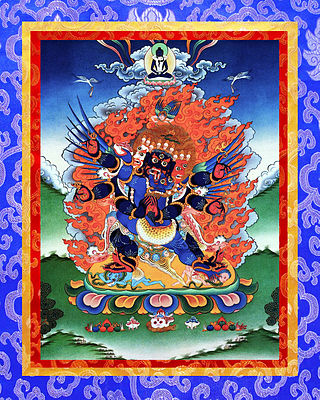
Vajrayāna, also known as Mantrayāna, Guhyamantrayāna, Tantrayāna, Secret Mantra, Tantric Buddhism, and Esoteric Buddhism, is a Buddhist tradition of tantric practice that developed in the medieval Indian subcontinent and spread to Tibet, Nepal, other Himalayan states, East Asia, and Mongolia.

In Buddhism, wrathful deities or fierce deities are the fierce, wrathful or forceful forms of enlightened Buddhas, Bodhisattvas or Devas ; normally the same figure has other, peaceful, aspects as well. Because of their power to destroy the obstacles to enlightenment, they are also termed krodha-vighnantaka, "Wrathful onlookers on destroying obstacles". Wrathful deities are a notable feature of the iconography of Mahayana and Vajrayana Buddhism, especially in Tibetan art. These types of deities first appeared in India during the late 6th century, with its main source being the Yaksha imagery, and became a central feature of Indian Tantric Buddhism by the late 10th or early 11th century.

Mahasiddha is a term for someone who embodies and cultivates the "siddhi of perfection". A siddha is an individual who, through the practice of sādhanā, attains the realization of siddhis, psychic and spiritual abilities and powers.

Tara, Ārya Tārā, or śyāmatārā, also known as Jetsün Dölma, is an important figure in Buddhism, especially revered in Tibetan Buddhism. She appears as a female bodhisattva in Mahayana Buddhism, and as a female Buddha in Vajrayana Buddhism. She is known as the "mother of liberation", and represents the virtues of success in work and achievements. She is known as Duōluó Púsà (多羅菩薩) in Chinese Buddhism, and as Tara Bosatsu (多羅菩薩) in Japan.
A yidam or iṣṭadevatā is a meditational deity that serves as a focus for meditation and spiritual practice, said to be manifestations of Buddhahood or enlightened mind. Yidams are an integral part of Vajrayana, including both Tibetan Buddhism and Shingon, which emphasize the use of esoteric practices and rituals to attain enlightenment more swiftly. The yidam is one of the three roots of the inner refuge formula and is also the key element of deity yoga. Yidam is sometimes translated by the term "tutelary deity".

The phurba or kīla is a three-sided peg, stake, knife, or nail-like ritual implement deeply rooted in Indo-Tibetan Buddhism and Bön traditions. Its primary association is with the meditational deity Vajrakīlaya, embodying the essence of transformative power. The etymology and historical context of the term reveal some debate, as both "phurba" and "kīla" can be used interchangeably in sources.

The Cakrasaṃvara Tantra is an influential Buddhist Tantra. It is roughly dated to the late 8th or early 9th century by David B. Gray. The full title in the Sanskrit manuscript used by Gray's translation is: Great King of Yoginī Tantras called the Śrī Cakrasaṃvara (Śrīcakrasaṃvara-nāma-mahayoginī-tantra-rāja). The text is also called the Discourse of Śrī Heruka (Śrīherukābhidhāna) and the Samvara Light (Laghusaṃvara).
Mahāyoga is the designation of the first of the three Inner Tantras according to the ninefold division of practice used by the Nyingma school of Tibetan Buddhism.

Vajrayoginī is a Tantric Buddhist female Buddha and a ḍākiṇī. The Vajrayogini cult dates back to the tenth and twelfth centuries. Vajrayoginī's essence is "great passion" (maharaga), a transcendent passion that is free of selfishness and illusion—she intensely works for the well-being of others and for the destruction of ego clinging. She is seen as being ideally suited for people with strong passions, providing the way to transform those passions into enlightened virtues.

The Buddhist Tantras are a varied group of Indian and Tibetan texts which outline unique views and practices of the Buddhist tantra religious systems.

The Trikāya doctrine is a fundamental doctrine within Mahayana and Vajrayana Buddhism that delineates the multidimensional nature of a Buddha's existence. This concept posits that a Buddha has three distinct bodies or aspects, each representing a different facet of enlightenment. The first body is the Dharmakaya, often referred to as the "Dharma body" or ultimate reality. This embodies the essence of enlightenment itself, encompassing concepts like emptiness, Buddha nature, and pure existence beyond material and spiritual forms.

Tibetan tantric practice, also known as "the practice of secret mantra", and "tantric techniques", refers to the main tantric practices in Tibetan Buddhism. The great Rime scholar Jamgön Kongtrül refers to this as "the Process of Meditation in the Indestructible Way of Secret Mantra" and also as "the way of mantra," "way of method" and "the secret way" in his Treasury of Knowledge. These Vajrayāna Buddhist practices are mainly drawn from the Buddhist tantras and are generally not found in "common" Mahayana. These practices are seen by Tibetan Buddhists as the fastest and most powerful path to Buddhahood.

In Tibetan Buddhism, Vajrakilaya or Vajrakumara is a wrathful heruka yidam deity who embodies the enlightened activity of all the Buddhas. His practice is known for being the most powerful for removing obstacles and destroying the forces hostile to compassion. Vajrakilaya is one of the eight deities of Kagyé.

The fundamental practice of Vajrayana and Tibetan tantra is deity yoga (devatayoga), meditation on a chosen deity or "cherished divinity", which involves the recitation of mantras, prayers and visualization of the deity, the associated mandala of the deity's Buddha field, along with consorts and attendant Buddhas and bodhisattvas. According to the Tibetan scholar Tsongkhapa, deity yoga is what separates Tantra from Sutra practice.
In Tibetan Buddhism and Bön, Zhitro or Shitrozab-chos zhi khro dgongs pa rang grol, also known as kar-gling zhi-khro refers to a cycle of teachings revealed by the terton Karma Lingpa and traditionally believed to have been written by Padmasambhava. The practices involve a mandala of 100 peaceful (zhi) and wrathful (khro) tantric deities and associated teachings and tantric practices which focus on those deities which represent the purified elements of the body and mind. These hundred peaceful and wrathful deities are believed to manifest to a deceased person following the dissolution of the body and consciousness whilst they are in the intermediate state, or bardo, between death and rebirth. The Bardo Thodol, commonly known in the West as "The Tibetan Book of the Dead", forms one section of Karma Lingpa's Zhitro cycle. The Zhitro teachings are closely related to the Guhyagarbha Tantra and are considered an Inner Tantra.
Gyurme Thekchok Tenzin was the 2nd Dzogchen Rinpoche of Tibet.
The Mahāmāyā Tantra, is an important Buddhist Anuttarayoga tantra or Yoganiruttaratantra particularly associated with the practice of Dream Yoga.

A charnel ground is an above-ground site for the putrefaction of bodies, generally human, where formerly living tissue is left to decompose uncovered. Although it may have demarcated locations within it functionally identified as burial grounds, cemeteries and crematoria, it is distinct from these as well as from crypts or burial vaults.

Tsangnyön Heruka, was an author and a master of the Kagyu school of Tibetan Buddhism. Born in Tsang, he is best known as a biographer and compiler of the Life of Milarepa and The Collections of Songs of Milarepa, both classics of Tibetan literature.
Classes of Tantra in Tibetan Buddhism refers to the categorization of Buddhist tantric scriptures in Indo-Tibetan Buddhism. Tibetan Buddhism inherited numerous tantras and forms of tantric practice from medieval Indian Buddhist Tantra. There were various ways of categorizing these tantras in India. In Tibet, the Sarma schools categorize tantric scriptures into four classes, while the Nyingma (Ancients) school use six classes of tantra.















